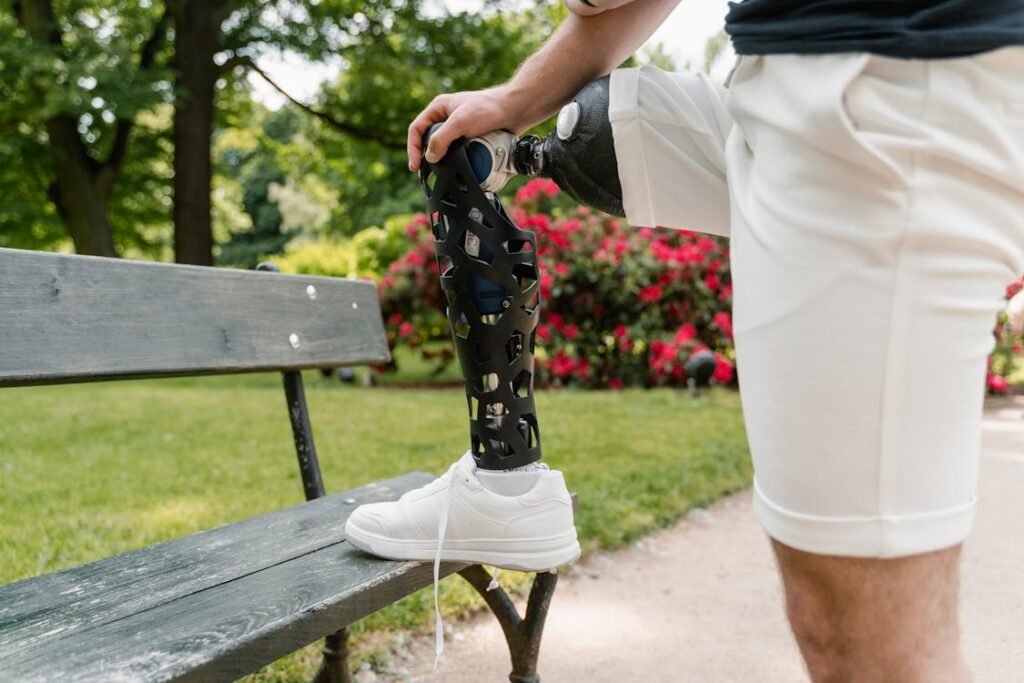Running a marathon is one of the greatest tests of endurance, discipline, and determination. For amputees, the challenge may seem even greater, but with the right training, mindset, and a high-performance running blade prosthetic, it is absolutely achievable. Running blades are designed to provide the power, flexibility, and shock absorption needed to sustain long-distance running. But using one effectively requires practice, conditioning, and a structured approach to training.
Training for a marathon with a running blade is different from training with a natural leg. It requires adaptation, muscle strengthening, and learning how to use the prosthetic efficiently. The body needs time to adjust to the mechanics of the blade, and the training must focus not only on endurance but also on technique, balance, and injury prevention.
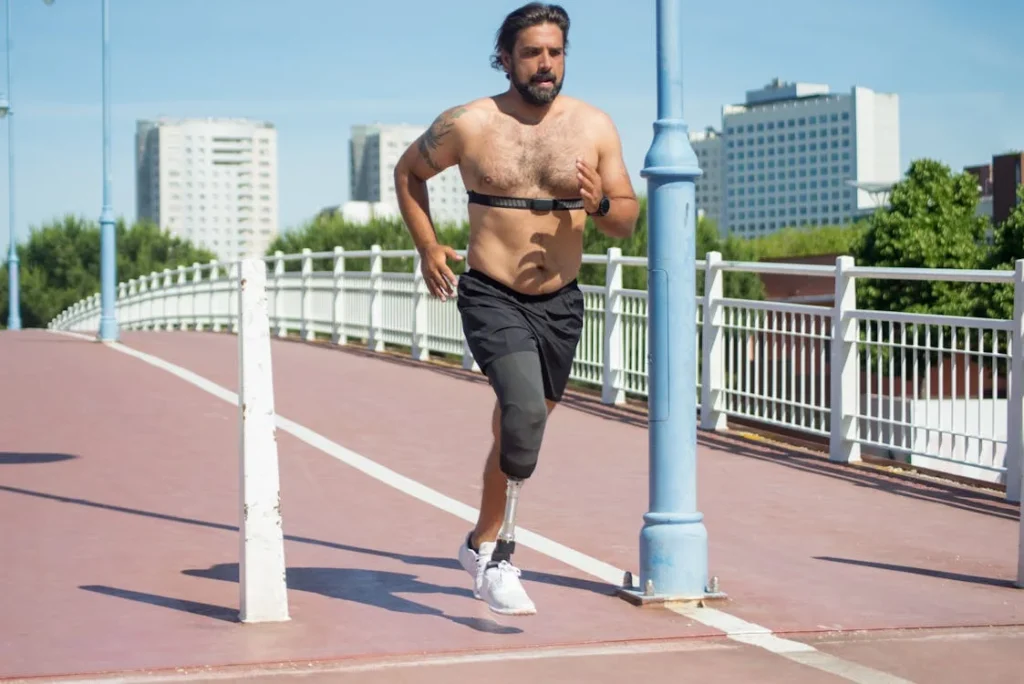
Understanding How a Running Blade Works
A running blade prosthetic is not like a regular prosthetic leg. It is designed specifically for high-speed movement, using energy-returning materials to help propel a runner forward.
The curved shape of the blade stores energy when it touches the ground and releases it when the runner lifts off, mimicking the natural motion of a biological foot.
However, running with a blade is different from running with a natural limb. The lack of an ankle joint means runners must adjust their stride to compensate.
Most running blades are slightly longer than the intact leg to balance out the energy return and avoid excessive strain on the body. It takes time to get used to the mechanics, and training must focus on learning how to use the blade efficiently.
Choosing the right blade is crucial. Different blades are designed for different activities, and marathon running requires one that is optimized for endurance rather than sprinting.
A well-fitted socket, proper alignment, and adjustments by a prosthetist ensure that the blade is comfortable and functional for long-distance running.
Developing Endurance and Stamina
Training for a marathon means gradually increasing your endurance so that your body can handle running for hours at a time.
For amputees using a running blade, this process is even more important because it allows the muscles and residual limb to adapt to the demands of long-distance running.
The first step is to start slow. Rushing into long distances too quickly can lead to fatigue, discomfort, or even injuries. New blade runners should begin with short runs and gradually increase distance over time.
Running with a blade engages different muscle groups compared to running with a natural leg, so the body needs time to strengthen and adapt.
A consistent training schedule is key. Most marathon training plans last between 12 to 20 weeks, with a focus on gradually building endurance.
Long runs are introduced once a week to simulate race conditions, while shorter runs help improve speed and recovery. Cross-training activities such as cycling or swimming can also help improve overall endurance without putting too much strain on the residual limb.
Rest and recovery are just as important as training. Overuse can cause soreness or irritation in the residual limb, so listening to the body and allowing time for recovery prevents injuries and ensures long-term progress.
Perfecting Running Form with a Blade
Running with a blade requires adjustments to form and technique. Unlike a biological foot, a running blade does not provide the same sensory feedback, so runners must rely on other cues to maintain balance and efficiency.
One of the biggest differences is the push-off phase. Since the blade absorbs energy and releases it, runners must learn to time their stride correctly.
The key is to avoid overcompensating by taking exaggerated steps or leaning too far forward. Keeping a steady, controlled stride ensures smoother movement and reduces unnecessary energy loss.
Posture plays a crucial role. Many new blade runners struggle with leaning to one side, especially if they are not used to the asymmetric mechanics of running with a prosthetic. Strengthening the core and maintaining a straight, upright posture helps with balance and stability.
The placement of the blade on the ground also matters. Landing too far forward on the blade can lead to instability, while landing too far back reduces the effectiveness of the energy return.
Practicing foot placement drills with a coach or prosthetist can help refine running mechanics and prevent inefficiencies.
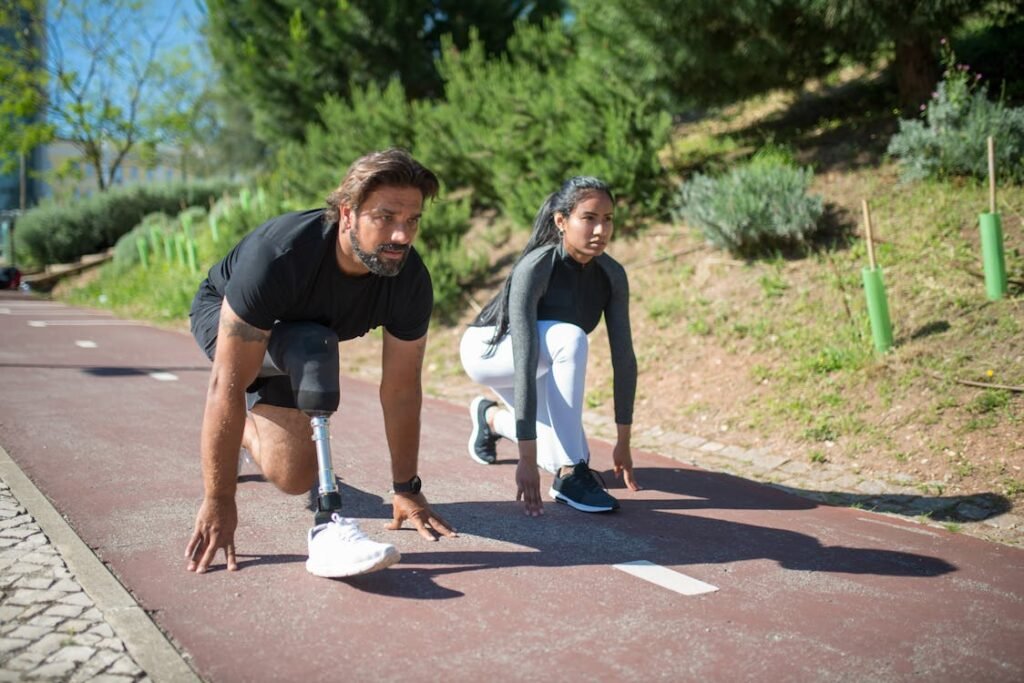
Strength Training for Marathon Runners with a Running Blade
Running a marathon is not just about endurance—it’s also about strength. Since running with a blade puts different demands on the body, targeted strength training is essential for maintaining balance, preventing injuries, and improving overall performance.
One of the most important areas to strengthen is the core. A strong core stabilizes the body, allowing for better control and balance while running.
Without an ankle joint to make micro-adjustments, the body must rely more on the core to stay upright and move efficiently. Exercises such as planks, leg raises, and rotational movements help improve stability and reduce strain on the lower back.
The legs also need to be strong, especially the intact limb. Many amputee runners naturally put more weight on their intact leg, leading to muscle imbalances and potential overuse injuries.
Strengthening the quadriceps, hamstrings, and calves ensures that both sides of the body can handle the stress of marathon running. Squats, lunges, and step-ups help build strength while improving symmetry in movement.
For the residual limb, targeted exercises help improve endurance and prevent fatigue. Many runners use resistance bands or light weights to engage the muscles in the remaining portion of the leg, ensuring that it remains strong and active throughout the race.
Upper body strength should not be neglected either. While running is primarily a lower-body activity, the arms play a critical role in maintaining rhythm and momentum.
A strong upper body helps with balance, especially when running long distances where fatigue sets in. Exercises like push-ups, rows, and shoulder presses contribute to overall endurance and efficiency.
Managing Residual Limb Comfort and Prosthetic Fit
Long-distance running places significant stress on the residual limb, so ensuring comfort and proper prosthetic fit is crucial for avoiding pain, blisters, and skin irritation.
The socket, which connects the residual limb to the blade, must be well-fitted to prevent friction. Any movement within the socket can cause chafing, leading to sores or discomfort that can make running painful.
Runners should work closely with a prosthetist to fine-tune the fit and make necessary adjustments as their training progresses.
Sweat management is another challenge. Running long distances generates heat, and excessive sweating inside the socket can lead to slippage and irritation.
Many runners use moisture-wicking liners or specialized prosthetic socks to keep the residual limb dry and comfortable. Some prosthetic systems also include vacuum suspension technology, which helps create a secure, sweat-resistant fit.
Taking care of the skin is essential. Marathon training involves hours of continuous movement, so keeping the residual limb clean and moisturized helps prevent dryness and irritation.
Checking for pressure points or redness after each run ensures that any potential issues are addressed before they become serious.
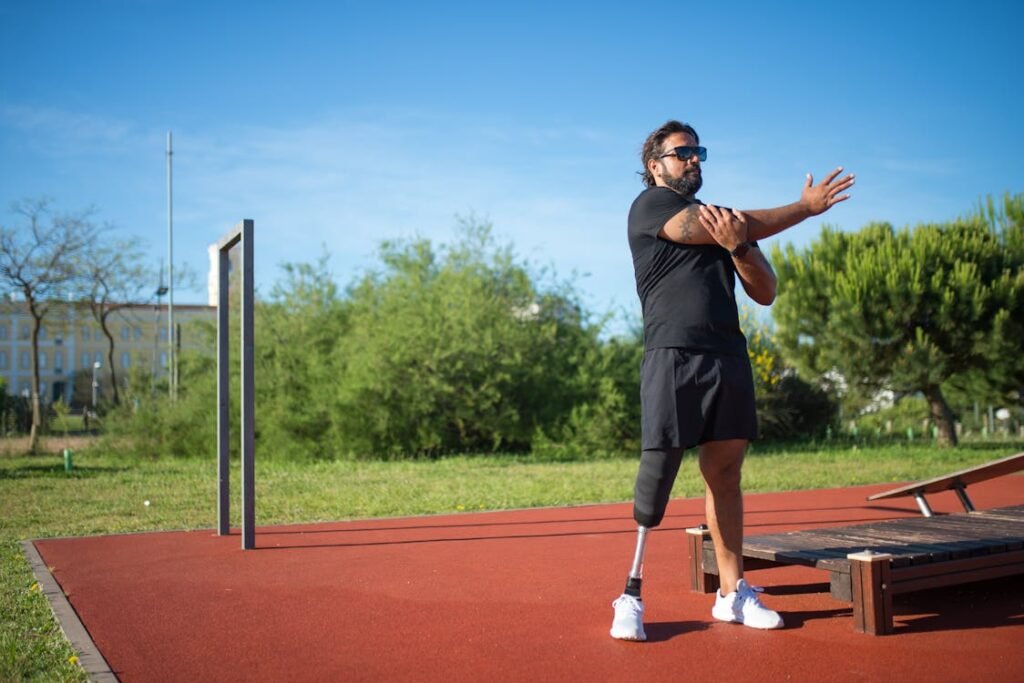
Building Mental Toughness for Marathon Running
Running a marathon is as much a mental challenge as it is a physical one. The long hours of training, the discomfort of fatigue, and the mental battle of pushing through pain require incredible mental strength.
For runners using a prosthetic, additional challenges such as adapting to a running blade, overcoming setbacks, and managing prosthetic-related discomfort make mental preparation even more critical.
One of the biggest mental hurdles is self-doubt. Many amputee runners, especially those training for their first marathon, question whether they can complete the distance.
The key to overcoming doubt is breaking the goal into smaller, manageable milestones. Instead of focusing on 42.2 km all at once, runners should celebrate each training milestone—whether it’s completing their first 5 km run, reaching a new personal best, or running longer without discomfort.
Small victories build confidence and reinforce the belief that the marathon is achievable.
Another mental challenge is dealing with discomfort. Every marathon runner experiences moments of fatigue, soreness, and mental exhaustion.
For blade runners, these challenges can be amplified by prosthetic fit issues, changes in running mechanics, or unexpected discomfort in the residual limb.
The best way to prepare for these moments is through mental conditioning—learning to recognize discomfort as part of the process rather than a signal to stop.
Techniques such as visualization, controlled breathing, and positive self-talk help runners push through tough moments during long training runs and on race day.
Visualization is a powerful tool. Many elite athletes use this technique to mentally prepare for races.
By imagining themselves running smoothly, overcoming fatigue, and crossing the finish line, runners can strengthen their mental resilience and improve performance. Seeing success in the mind makes it more likely to happen in reality.
Mindfulness and meditation can also be helpful. Many endurance runners practice mindful running—staying present in the moment rather than worrying about the miles ahead.
This reduces stress and helps runners stay focused, especially during the later stages of the marathon when fatigue sets in.
Race Day Strategy for Amputee Runners
After months of training, race day is the ultimate test. Proper pacing, hydration, and energy management are key to completing the marathon successfully.
One of the most important aspects of marathon strategy is pacing. Many first-time runners make the mistake of starting too fast, only to burn out later in the race.
Blade runners must be especially mindful of their energy output since running with a prosthetic requires a different level of exertion. Maintaining a steady, controlled pace in the first half of the race ensures enough energy for the final stretch.
Hydration and nutrition play a major role in performance. Long-distance running depletes the body’s energy stores, and refueling with carbohydrates, electrolytes, and fluids helps maintain endurance.
Amputee runners should also consider how hydration affects their prosthetic fit—excessive sweating or swelling in the residual limb can impact comfort, so drinking the right amount of fluids without overhydrating is important.
Having a support system on race day can make a huge difference. Whether it’s family, friends, or fellow runners, encouragement from the sidelines can provide an extra boost of motivation.
Many marathon runners experience mental fatigue in the final kilometers, and having supporters cheering them on helps push through the toughest moments.
The final stretch of the marathon is where mental and physical preparation truly pay off. Every runner, regardless of ability, feels exhaustion in the last few kilometers.
For amputee runners, this moment is an opportunity to reflect on the journey—how far they’ve come, the challenges they’ve overcome, and the strength they’ve built through training.
Crossing the finish line is not just about completing the race; it’s about proving that determination and resilience can overcome any obstacle.
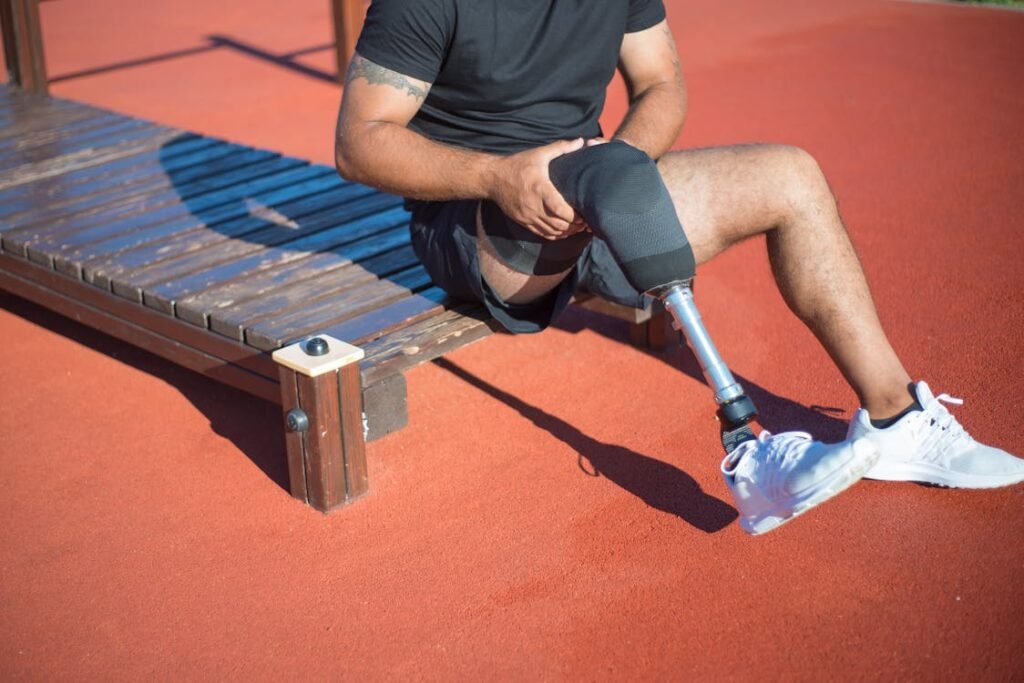
Recovery and Injury Prevention After a Marathon
Finishing a marathon is a huge achievement, but the work doesn’t stop at the finish line. Recovery is just as important as training, especially for runners using a prosthetic.
The intense physical effort of running 42.2 km takes a toll on the body, and proper post-race care ensures that runners heal, regain strength, and prepare for future races without injury.
One of the first steps in recovery is addressing muscle soreness. Long-distance running causes micro-tears in the muscles, leading to stiffness and fatigue.
Gentle stretching, foam rolling, and light walking help loosen tight muscles and promote blood circulation. For amputee runners, stretching is especially important for maintaining flexibility in the intact leg and preventing imbalances caused by overuse.
The residual limb also requires extra attention. The prolonged friction and pressure from the prosthetic socket can cause minor irritation or swelling.
After the race, runners should remove their prosthetic, inspect the skin for any redness or soreness, and apply soothing creams or anti-chafing balms as needed. If blisters or pressure sores develop, giving the limb time to heal before resuming training is essential.
Hydration and nutrition play a key role in recovery. The body loses fluids and essential minerals during the marathon, and replenishing them helps speed up muscle repair.
Eating nutrient-rich foods with protein, healthy fats, and complex carbohydrates supports tissue recovery and restores energy levels. Many runners also use electrolyte drinks to help rebalance their body’s hydration levels.
Rest is one of the most powerful recovery tools. While it may be tempting to start running again right away, the body needs time to rebuild after the physical strain of the race.
Most experts recommend taking at least a few days off before resuming light training. Walking, swimming, or cycling can help maintain fitness without putting excessive stress on the legs.
Long-term injury prevention is crucial for runners who plan to continue racing. Regular visits to a prosthetist ensure that the running blade remains in optimal condition and that the socket fit is still comfortable.
Over time, changes in muscle mass or running mechanics can affect how the prosthetic fits, so making adjustments when needed helps prevent pain and discomfort.
Cross-training is another effective way to prevent injuries. Strength training, yoga, and low-impact activities help improve flexibility, balance, and overall resilience.
By strengthening the muscles that support the residual limb and intact leg, runners reduce the risk of overuse injuries and maintain their ability to run at peak performance.
Setting New Goals After a Marathon
Completing a marathon is a life-changing accomplishment, but for many runners, it is just the beginning. The experience of training, overcoming obstacles, and crossing the finish line builds confidence and motivation to take on new challenges.
Some runners set goals to improve their marathon time, while others explore different distances such as half marathons or ultramarathons.
The sense of achievement gained from completing a marathon can also inspire runners to mentor or support other amputees who are just beginning their running journey.
Joining running communities, participating in charity races, or even training for international events keeps the momentum going. The key is to keep challenging both the body and mind, embracing the journey rather than focusing solely on the next big race.
Every marathon is proof of what is possible with dedication, perseverance, and the right support. Running with a prosthetic is not just about completing a race—it’s about breaking barriers, redefining limits, and proving that no challenge is too great to overcome.
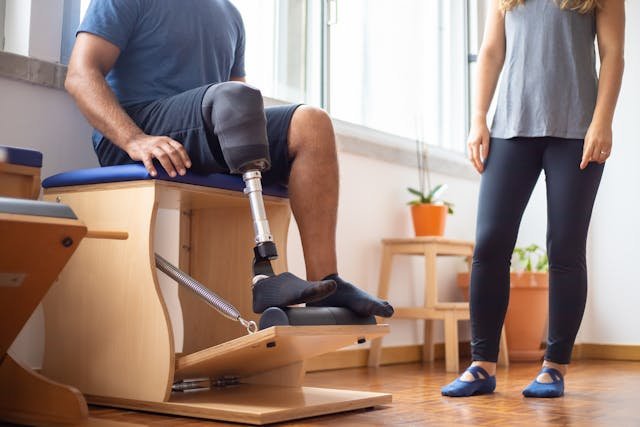
The Role of Technology in Enhancing Running Blade Performance
Running blade technology has come a long way, transforming how amputees train and compete in marathons. Modern prosthetics are no longer just about replacing a limb; they are designed to optimize performance, improve comfort, and enhance efficiency.
As technology continues to advance, running blades are becoming more refined, offering better energy return, adaptability, and durability for long-distance running.
How Running Blade Design Affects Performance
The shape and material of a running blade determine how well it functions. Traditional prosthetic legs were designed primarily for walking, but running blades use high-performance carbon fiber to store and release energy with every stride.
The curved design acts like a spring, absorbing impact when the foot strikes the ground and returning energy to help propel the runner forward.
However, not all blades are the same. Sprinters use stiff, aggressive blades designed for explosive power, while marathon runners need blades that balance energy efficiency with endurance.
Long-distance blades are slightly more flexible, allowing for a smoother stride and reducing fatigue over time.
Blade length and alignment are also crucial. Many runners use a blade that is slightly longer than their intact leg to compensate for the lack of an ankle joint. Proper alignment ensures that energy is transferred efficiently, preventing excessive strain on the hips and lower back.
Smart Prosthetics and Sensor Technology
One of the most exciting advancements in running prosthetics is the integration of smart technology. Researchers are developing sensor-equipped prosthetics that can track movement, adjust stiffness, and provide real-time data to improve running mechanics.
Some smart prosthetics use artificial intelligence to adapt to a runner’s gait, making automatic adjustments based on terrain and running speed.
This technology allows for a more natural and responsive running experience, reducing the need for manual tuning and fine-tuning prosthetic settings for different training conditions.
Pressure sensors inside the socket can also help prevent injuries by detecting excessive stress points on the residual limb.
By analyzing this data, runners and prosthetists can make informed decisions about fit adjustments, reducing the risk of blisters, sores, or discomfort during training.
The Future of Running Blade Innovation
As research continues, we can expect even more breakthroughs in prosthetic technology. Scientists are exploring the potential of bionic limbs that use neural connections to mimic real muscle movement, offering even greater control and efficiency.
Another area of innovation is adaptive shock absorption. Since long-distance running involves repetitive impact, future running blades may incorporate materials that dynamically adjust their cushioning based on speed and terrain.
This could make marathons easier on the joints and improve endurance for blade runners.
The fusion of biomechanics, materials science, and AI-driven adjustments is bringing running prosthetics closer than ever to natural human movement.
With each technological leap, amputee runners gain greater control, comfort, and confidence, proving that the future of marathon running is more inclusive and limitless than ever before.
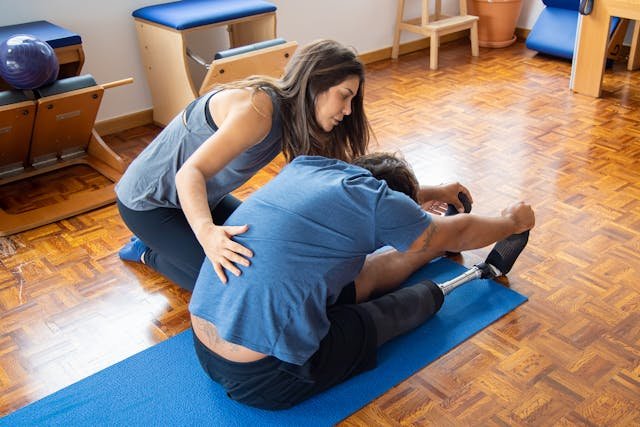
The Role of Prosthetists and Coaches in Marathon Training
Training for a marathon with a running blade is not a solo journey. While personal dedication and discipline are key, the support of experienced professionals—prosthetists and running coaches—plays a crucial role in ensuring success.
From selecting the right prosthetic components to refining running mechanics, these experts provide the guidance needed to train efficiently and avoid injuries.
The Prosthetist’s Role in Optimizing Performance
A well-fitted running blade can make the difference between a smooth, energy-efficient run and discomfort that hinders progress. Prosthetists specialize in customizing the fit, alignment, and functionality of the blade to match the runner’s needs.
They assess factors such as socket comfort, suspension system effectiveness, and energy return properties of the blade.
During the early stages of training, a prosthetist helps runners adjust to the unique movement patterns of their prosthetic. Small modifications in socket alignment or blade stiffness can significantly impact efficiency, balance, and endurance.
Regular check-ins ensure that the prosthetic continues to fit properly, especially as muscle tone and fitness levels change over months of training.
Sweat management and skin protection are also areas where prosthetists provide valuable insights. Marathon training involves long hours of running, which can lead to excessive moisture buildup inside the socket.
Prosthetists recommend breathable liners, moisture-wicking socks, and suspension systems that prevent slippage, keeping the runner comfortable over extended distances.
The Running Coach’s Role in Technique and Endurance
A skilled running coach understands that training with a prosthetic is not the same as training with a natural limb. The mechanics of running with a blade require adjustments in stride length, foot placement, and weight distribution.
Coaches work closely with amputee runners to refine their form, prevent overcompensation, and develop an efficient running style.
One key area of focus is pacing strategy. Since running blades provide energy return but lack an ankle joint for natural shock absorption, pacing must be controlled to prevent early fatigue.
Coaches help runners find their optimal rhythm, ensuring that energy is conserved for the latter stages of the marathon.
Another essential aspect is strength and conditioning. Coaches design customized training programs that target the specific muscle groups used in running with a blade.
Exercises to strengthen the core, hips, and intact leg reduce the risk of imbalances and injuries. Coaches also incorporate flexibility drills to improve overall movement efficiency.
Mental preparation is another area where a coach can make a huge impact. Many amputee runners experience moments of frustration while adapting to their prosthetic, and having a knowledgeable coach provides encouragement, motivation, and solutions to challenges.
Training is not just about physical endurance—it’s about believing in the body’s ability to complete the marathon.
The Power of a Support System
Beyond prosthetists and coaches, a strong support system—including family, fellow runners, and training partners—helps keep motivation high.
Running communities often welcome amputee athletes with open arms, providing an environment of encouragement and shared experiences.
The journey to a marathon is filled with highs and lows, but with the right team in place, every challenge becomes an opportunity for growth.
The combined expertise of prosthetists, coaches, and support networks ensures that runners can focus on what truly matters—crossing the finish line with strength and confidence.
Conclusion
Training for a marathon with a running blade is a journey of endurance, adaptation, and determination. It requires not only physical preparation but also mental resilience, the right prosthetic fit, and a well-structured training plan. With proper guidance from prosthetists and coaches, runners can refine their technique, prevent injuries, and optimize their performance.
While challenges like balance, prosthetic comfort, and pacing exist, they can all be overcome with patience and consistent training. Strength conditioning, mental preparation, and recovery strategies play a crucial role in ensuring that runners reach the starting line ready and cross the finish line strong.
Beyond the race itself, marathon training transforms confidence and mindset. Every step taken is proof that limitations exist only in the mind. Running with a prosthetic is not just about covering distance—it’s about proving that no challenge is too great to overcome.
For those ready to take on the 42.2 km challenge, the road ahead may be demanding, but the reward is unmatched. With dedication, support, and the right approach, crossing the finish line is not just possible—it’s inevitable. Keep training, keep believing, and most importantly, keep running.



